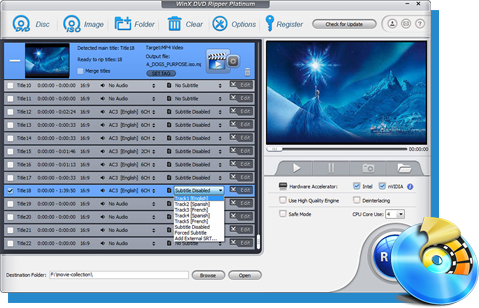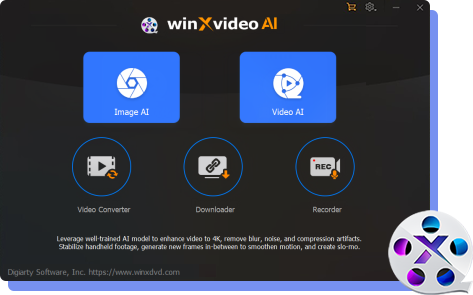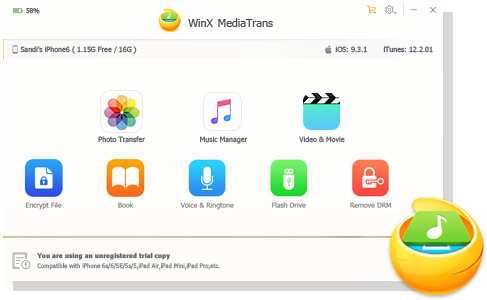What Is AV1 Codec? Where and How Can You Play AV1 Smoothly?
Summary: AV1 is a royalty-free, open-source video codec offering superior compression efficiency compared to HEVC, VP9, and H.264. It’s optimized for internet streaming, providing high-quality video at lower bitrates. Supported by major browsers and platforms like YouTube and Netflix, AV1 is set to become the future of online video. Follow the page and get an indepth review of AV1 codec.
Here is the champion, named "HEVC", who has dominated the codec tournament for years. His coach, the grandmaster "MPEG LA" stand behind the stage, pride and confidence, expecting for the next knock out. Now here comes a new challenger, the "AV1, Rocky Balboa" for the next generation of video codec standard, step to the stage, with the cheer and triumph from his supporters, those "Tech-giants". The video codec battle is about to begin. In the post, you are informed of everything regarding to new AV1 codec.
Table of Contents
Part 1. What Is AV1 Codec and Its Background?
Part 2. The Main Advantages of AV1 Codec.
Part 3. AV1 vs HEVC vs VP9 vs H.264.
Part 4. Novel Techs that Make AV1 Different.
- • Film grain synthesis
- • Constrained directional enhancement filter
- • Frame super resolution
- • Non-binary arithmetic coding
Part 5. Where Can I Watch AV1 Video?
Part 6. How Do I Play AV1 File Successfully?
Part 7. FAQ about AV1 Codec.
Part 1. What Is AV1 Codec and Its Background?
AV1[1] is the latest video compression standard developed by the Alliance for the Open Media (AOM). It was first released on March 28, 2018. The initial validated version (1.0.0) was shot out on June 25, 2018, and their pace of evolving is quick as lightning. Several versions were released and some notorious issues for early versions have been significantly improved. For the year 2025, with only74 years of R&D, AV1 codec has become quite usable with many exciting features. Many consider AV1 codec will dominate the vided streaming market in all probability.
Why and how does the new codec progress so agile? The AOM[2] was the man behind the curtain. Established in September 2015, AOM was founded by the leading companies: Google, Mozilla, Apple and Microsoft, along with hardware vendors like AMD, ARM Intel and NVIDIA. Also, Amazon & Netflix joint the birth of AV1 codec. With all big names on board, AV1 adapted Google's previous VP9 technology and got the utmost support from Google AOM alliance members, making AV1 promising to become the new standard for a world of content.
Key Points About AV1's Background:
- Release Timeline: AV1 was initially launched in 2018 and has evolved rapidly since then.
- Industry Support: AOM includes key players such as Google, Netflix, Amazon, and more, making AV1 a well-supported, future-proof codec.
- Open-Source and Royalty-Free: AV1 is free from licensing fees, unlike HEVC, which charges high royalties through MPEG LA. This makes AV1 an attractive option for developers and content providers seeking to reduce costs and avoid patent fees.

Part 2. What Are the Main Advantages of AV1 Codec?
1. Royalty-free and open source. The most eye-catching spot for AV1 is its open and royalty-free strategy. It has become a controversial topic and unraveled the ambition that AOM wants to encroach the market share of HEVC codec, which released in 2013 by the MPEG-LA organization. Why the AOM need to take such an aggressive action against the HEVC? There are both technical and market concerns.
The MPEG-LA has dominated video codec standard for decades. A capable competitor did not appear until 2010 when Google VP8 joined the game. Established in the year 1988, the MPEG LA has accumulated a tremendous amount of video codec patent with a gigantic patent pool. As one thing to remind, their patent fee is just about insane.
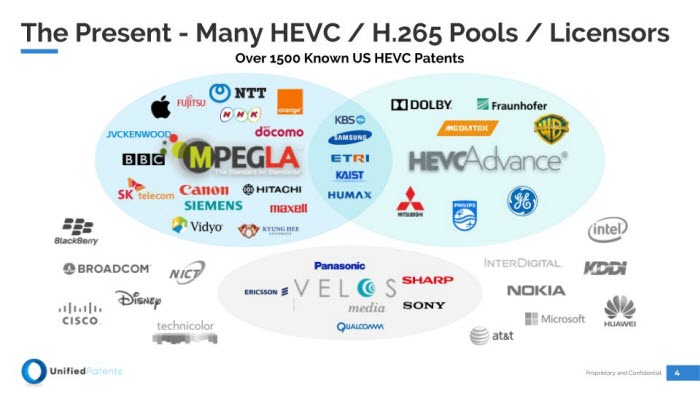
At this time, American leading tech companies are united to seek a new codec standard to bypass the existing MPEG codec patents, from an economic view, that will cut off a great amount of cost for online video/streaming contents providers like Google and Netflix. In conclusion, "Royalty-free" is their most distinct competitive advantage when compared to HEVC. Their "patent free" slogan has also attracted periphery companies to release their AV1 applications & add-ons, for example the Radiant media, MPV player, so on and so forth.
Codec |
Licensor |
Codec Royalties |
Royalty Exemptions |
Royalty Annual Cap |
Content Distribution Fee |
HEVC |
MPEG LA |
US$0.20 per unit |
First 100K units each year |
US$25 million |
US$0 |
HEVC |
HEVC Advance |
Region 1: |
US$25,000 each year |
US$40 million |
Physical distribution: |
HEVC |
Technicolor |
Tailor-made agreements |
Tailor-made agreements |
Tailor-made agreements |
US$0 |
AV1 |
Alliance for Open Media |
US$0 |
N/A |
N/A |
US$0 |
2. Optimized for the Internet Streaming. On the other hand, as a long-run, fully developed codec structure, HEVC codec can hardly adapt its self to modern internet transmission tasks. HEVC is not specifically optimized for internet video transmitting & data storage purpose and end up a result that hardly do improvement on it due to its original purpose (video codec for the broadcast market and streaming irrelevant). With the fact that streaming services are overtaking the previous broadcast business, service providers are eagerly seeking for a compact video format with comparatively decent graphic quality to pose the bandwidth solutions.
It is scalable to any modern device at any bandwidth and is designed with a low computational footprint and optimized for the internet and hardware. AV1 is capable of consistent, highest-quality, real-time fast video delivery, and is flexible for both commercial and non-commercial content, including user-generated content.

Part 3. AV1 vs HEVC vs VP9 vs H.264: Is AV1 Better than HEVC/H.265 or VP9?
The technical advantage that AV1 has, with its Achilles's heel in some domain, has become the topic discussed for a long term. Various debates are surrounding the argument that if the AV1 is a codec that capable for the future, with my answer is positive. Let it be clear: objectively if we need to measure the performance of a codec, we need to check in both two dimensions:
- Bitrate compression capability: with the same graphic quality setting, how compact the digitized video file could be achieved. In another term, a video file is at the highest compress rate, how good the graphic quality could be presented.
- Encoding and decoding: The encoding capability will present on the time taken to encode the raw clip to computer playable video format, it is not acceptable for content creators if it takes forever to encode their video. The decoding capability will significantly affect the user experience, the video play will sluggish/choppy if the decoder is incapable of a fast decoding on end-up devices.
Video codec comparison: AV1 vs HEVC, AV1 vs VVC, HEVC vs H.264
1. AV1 vs HEVC vs VP9 vs H.264: Quality and Bitrate Measurement
Put it to the practice. The standard for comparing different video codecs, we got to follow certain measurements & metrics. VMAF quality with the Moscow University Video Quality Measurement Tool is one of the greatest criterion which we can do to reference.
The encoding test will be based on four samples that will encode within 4 different codecs through FFmpeg. The encoding scripts will be kept as vanilla as it could be (N-93083-g8522d219ce) with minor adjustment to fit the insignificant, differentiated codec requirement to keep the comparison impartial and reasonable:
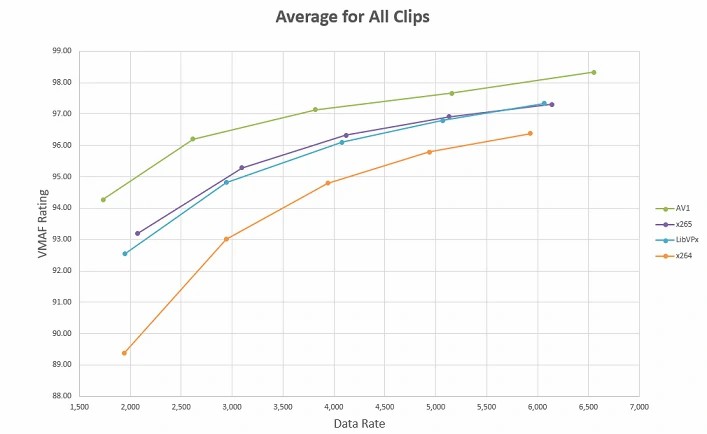
The vertical axis shows the VMAF scores which representing the graphic quality, a higher score simply means better quality of video (in almost all aspects). The horizontal axis represents the bitrate, again to put that in simple, smaller number means smaller video size & higher compression rate. Reasonably less compact if the coordinate is addressed on the right-hand side.
As a result, AV1 was the champion, H264 the laggard, and x265 and VP9 neck and neck in the middle. A noticeable evidence is AV1 got a very high VMAF grade even it's in an extremely low bitrate, which indicated that AV1 is super effective at a cut off the bandwidth of the video and keep the graphic quality retain a higher baseline, compared with HEVC, VP9 and H.264.
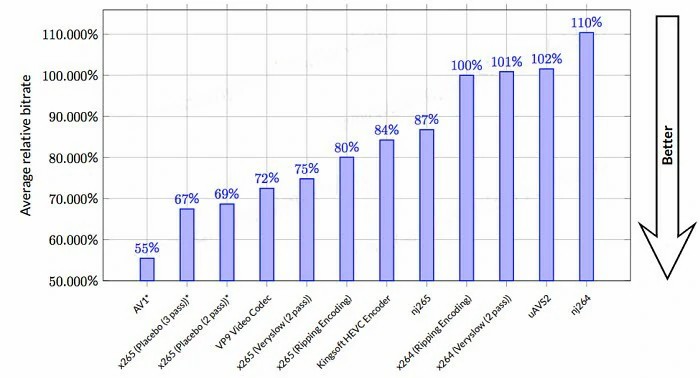
Not only the VMAF prove that AV1 is the winner quality-wise among its competitors. The PSNR (Peak Signal-to-Noise Ratio, see below) tests also regard AV1 codec as the leader of all codecs. Typically, AV1 codec is 30% better than HEVC in terms of the compression efficiency. It saves up to 30% in bandwidth for the same image quality in HEVC and 50% of VP9.
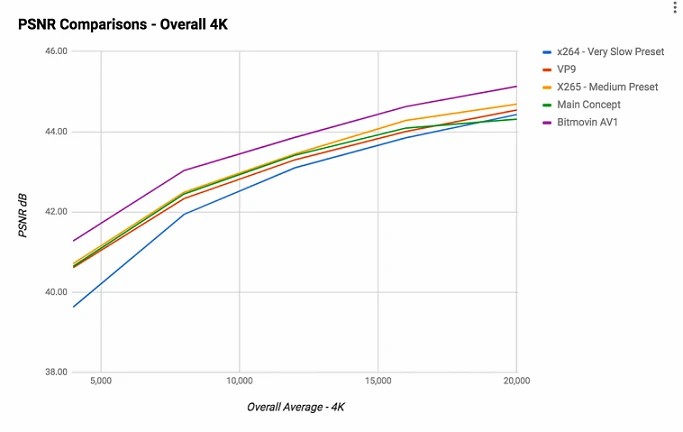
Here's how AV1 stacks up against other popular codecs:
- AV1 is up to 30% more efficient than HEVC (H.265) in terms of compression, meaning it can achieve similar video quality while using less bandwidth. This makes AV1 an excellent choice for streaming high-resolution content like 4K and HDR videos without overloading users' bandwidth.
- HEVC (H.265) is widely used, especially in 4K streaming, but it's less efficient than AV1. Although HEVC can compress files well, AV1 provides better quality at a lower bitrate, making it more future-proof.
- VP9 is similar to AV1 in terms of compression efficiency but falls short when it comes to quality at lower bitrates.
- H.264 (also known as AVC) is the most widely adopted codec, but it lags significantly in terms of compression efficiency compared to AV1 and HEVC.
Compression performance: AV1 > X265 > VP9 > X264
2. AV1 vs HEVC vs VP9 vs H.264: The Achilles's Heel - Encoding/Decoding Difficulty
The encoding/ decoding ability for video codec is a significant factor which end up with the user experience. Imagine a Youtube vlogger need a day or even longer time to encode his/her video before uploading, the time efficiency is literary intolerable. Unfortunately, AV1 is not performing ideally at encoding speed.
1. Encoding Speed
We set the initial FFmpeg string (max rate 3000~ 6000K, CPU used 8 cores and 2 passes) both for AV1, HEVC (H.265) and VP9 plus H.264. With a 95.55 VMAP score conformant, the time consumption of AV1 encoding isn't taking the lead. However, latest news reported that AV1 encoding on NVENC GeForce 40-series Ada GPUs[7] using FFMPEG outperforms HEVC by 75-100%, at comparable quality.
Encoding Time (seconds) |
Times Real Time |
|
AV1 |
736 |
147 |
x265 |
289 |
58 |
LibVPx |
226 |
45 |
x264 |
18 |
4 |
What can we conclude from the table: Data depicts that the AV1 is about 3x the encoding times of x265 and VP9, and the graphic quality was compromised to 95.55 from 96.18. Even though the sharpest-eyed viewer wouldn't notice this .63 differential, but if we do compare it pin to pin, then the results are embarrassing.
2. Decoding Speed
A 6Mbps Elekstra file is converted to Y4M format with FFmpeg script in order to test the decoding speed. From the image, you can see AV1 decoded at .66x real time, with H.264 at 14x, VP9 at 10.5x, and HEVC at 8x real time.
On the other hand, when FFplay is used to play all four files. AV1 won't play at all, which is probably not surprising since it is still in experimental status, while VP9, HEVC, and H.264, HEVC all played in real time with minimal use of CPU.
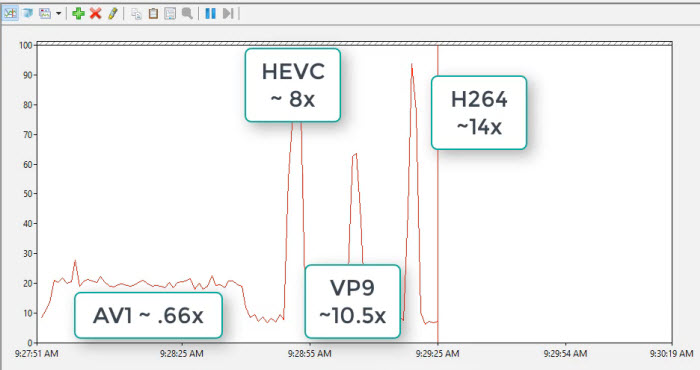
Conclusion on Encoding and Decoding Speed:
- Best for Speed: H.264 is still the fastest codec for both encoding and decoding.
- Improvement Needed: AV1 still faces significant speed challenges, especially in encoding and decoding. However, with hardware acceleration and software optimizations, these issues should improve over time.
What takes AV1 codec to such a consequence? As one of the initial purposes when designing AV1 at the beginning stage, hardware compatibility was in their major concerns. The ultimate solution for compatibility issues will be a "virtual machine" stuff like Java, which idea doesn't fit the computer video industry. So the designers of AV1 codec deducted the hardware dependence, meanwhile, the hardware acceleration is disabled. Their goal is to make AV1 codec video able to run on various devices as possible. But the encoding performance is sacrificed as a result.
But there is hope. AV1 codec was released in 2018 and still evaluated as an underdevelopment project with pretty much capable for business use. Consider Google, Microsoft, Amazon, and Apple joined this race, with their talented, experienced developers trying their best to ingratiate the market needs, it's highly promising that the problem will be relieved in near future.
Part 4. What Makes AV1 Different - Innovative Coding Algorithm?
AV1 is considered a cutting-edge project, with major tech giants announcing the implementation of several groundbreaking features that make it stand out from other video codecs. Let's take a closer look at four of these innovations that could shape the future of video compression.
1. Film Grain Synthesis
We've had the experience when film grain appears on over enlarged pictures, but it could also be a form of artist expressiveness. In the previous encoding scenario, the codec could hard to distinguish it from the constant noise and creates a great amount of traffic in the bitstream. High bitrate video compensated for transmitting very little information. Since human brains tend to filter the visual noise and accept them as a bit "emotional" sensation, to find a way to not transfer the noise with the bitstream but re-apply it in the later procedure, could be a desirable solution.
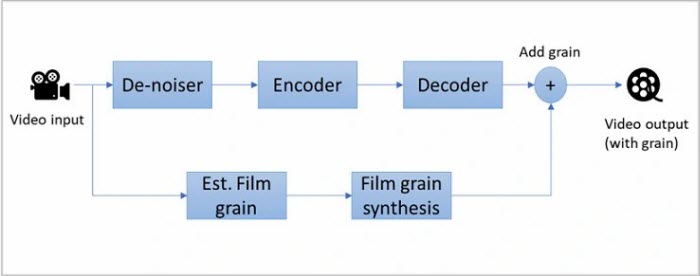
2. Constrained Directional Enhancement Filter
As the essential process of all video codecs, the effectiveness of filtering will dramatically influence the quality of encoded video. Each picture will be divided into small units during the encoding process by the lines and blocks. The directional filter is the advanced algorithm, supported by previous filters, CLPF and CDEF, to recognize the edges of each frame with analyzing their direction, low-pass filters along the edges and outlines will be applied and the graphic quality improves since smoother lines and visual effects are adapted.
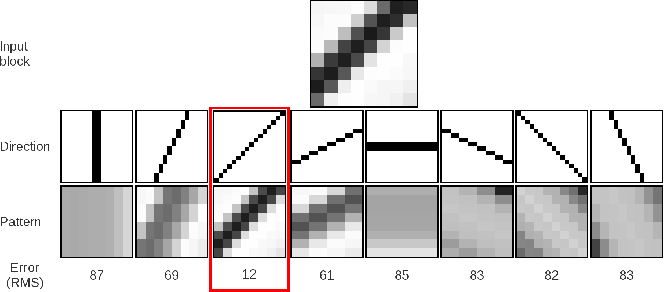
3. Frame Super Resolution
It is a common practice among video streaming services to adaptively switch the frame resolution based on the current bandwidth. For example, when the available bandwidth is low, a service may send lower resolution frames and then upscale them to the display device resolution. However, such a scaling occurs outside of the video codec as of now. The motivation behind the new Frame Super-resolution framework in AV1 is to make this scaling process more effective by making it a part of the codec itself. The new coding technic allows the lower spatial resolution frames to be coded at first and then super-resolved normatively recursively to adapt to full resolution before rendering the buffers. Later, these super-resolved reference buffers can be used to predict subsequent frames, even if they are at a different resolution.

4. Non-binary Arithmetic Coding
AV1 moves to using a symbol-to-symbol adaptive multi-symbol arithmetic coders (up to 8 possible values) instead of traditional HEVC coding (which have only two). The precision is much higher than a binary arithmetic encoder and enhances the tracking capabilities of less common elements of a visual element accurately. Through it's a complex process to coding to merge different values to one, it boosts code performance since multiple bits could process in the same clock cycles sequentially.
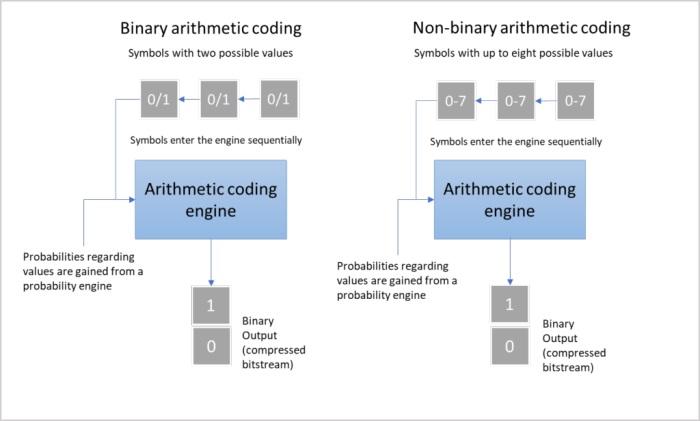
Part 5. Where Can You Watch AV1 Video?
Although AV1 is a relatively new video compression standard, its adoption is growing rapidly. For instance, the AV1 Video Extension was added to Microsoft's Windows 10 and Windows 11, the world's leading PC platforms. This is a significant move that reflects the codec’s increasing integration across major systems. So, where can you stream AV1 content? Many modern browsers now support AV1 playback, and content providers are increasingly adopting it.
1. Web browsers. Google, Microsoft, Mozilla, and other browser developers have successively added AV1 codec support. While the AV1 technical framework is still evolving, its superior compression performance and royalty-free nature are key factors behind its growing adoption. Firefox, Chrome, Microsoft Edge, Opera, and Vivaldi all support AV1. Specifically, Microsoft Edge and Firefox have supported AV1 since 2018, while Google Chrome added AV1 decoder support in version 70 (2018) and later introduced AV1 encoding in 2021 for enhanced video conferencing with WebRTC.
2. Streaming platforms. AV1 has seen growing adoption by major online content providers, including YouTube, Vimeo, Netflix, and Twitch, among others.
- YouTube: As the leading force of AOM, Google with its YouTube[3] has actively rolling out AV1 video. Beginning with AV1 Beta Launch Playlist with 14 playable videos in 2018. By 2025, YouTube has significantly expanded AV1's use, with AV1 being supported on all YouTube videos in 4K and beyond, and is continuing to grow in popularity as more users upgrade to AV1-enabled devices.
- Vimeo: Vimeo has been a key proponent of AV1, using Mozilla's Rav1e encoder to implement AV1 in its "Staff Picks" channel as early as 2019. Today, Vimeo is actively expanding its AV1 content library and plans to eventually support AV1 across all its uploaded videos.
- Netflix: Netflix officially started supporting AV1 on Android devices in February 2020 and has since expanded AV1 support across multiple platforms, including Smart TVs, desktop, and mobile. Netflix now streams a large portion of its 4K content in AV1, helping solidify the codec's role as a future-proof streaming solution.
- Twitch: Twitch began testing AV1 for its live streaming content in 2020 and has since expanded its use to improve streaming quality and reduce bandwidth usage. Additionally, Facebook (Meta) has been experimenting with AV1 for its platform, with the expectation of expanding its use in the future.
- iQIYI: There is also the first Chinese video streaming platform - iQIYI, who announced support for AV1 codec used on PC browser and Android device in 2020.
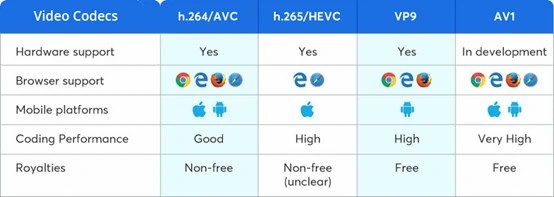
Note: AV1 will drastically change the landscape of the online video market with no doubt. However, right now, most media players or devices aren't ready for AV1 codec. You have to download external AV1 video extension beforehand or resort to a media player supporting AV1 video. On the other hand, AV1 video is typically contained by WebM, which is not well compatible with some devices. If you run into any problem with WebM video in AV1, you can convert WebM to MP4 first for smooth playing.
Part 6. How Do You Play AV1 Files?
Hence almost all decisive companies prospected their future with AV1 and we can see the growing implementation of AV1 codec video on various platforms & occasions, have we set to enjoy the changes and exciting content that AV1 brought to us? How do you play AV1 file successfully? Mostly, AV1 content playback relies on what hardware, software, and operating system you are working with.
In terms of hardware, Intel launched its Tiger Lake, Rocket Lake and Alder Lake CPUs in 2020 and 2021, providing fixed-function hardware for PC AV1 decode. NVIDIA announced the the first discrete GPUs - NVIDIA GeForce RTX 30 series[4] on Sep 1, 2020, which adapts the full AV1 hardware encoder/decoder for better AV1 video watching/streaming experience. In the same month, AMD added the support for AV1 decoding on RDNA2 GPUs. In July 2022, NVIDIA added support to the FFMPEG to allow for accelerated AV1 decoding for GPU RTX30 graphics through the VDPAU API.
While in March 2022, Intel beats Nvidia and AMD to become the industry first with full AV1 encoding support with its new Arc GPUs[6]. It is tested to have 50X faster than the software only AV1 encoding. Six months later Nvidia announced the Nvidia GeForce RTX 40 series with AV1 decoding and encoding. Click to learn more AV1 hardware support >>
In terms of software, except the browsers mentioned above, media players such as VLC v3.0[5] onwards, 5KPlayer v6.2 onwards, MPV v0.29.0 onwards, and Potplayer v1.7.14804 onwards can decode AV1 video. In the meanwhile, famous video editors incl. Davinci Resolve since v17.2 and Avidmux since v2.76 also added AV1 video decoding support, too. Besides, OBS studio announced the support of NVENC AV1 encoder for recording software. FFMPEG now supports faster Ada architecture encoders, following the implementation of Intel AV1 encoder.
In terms of operating system, Microsoft Windows introduced Windows 10 October 2018 Update (1809) with AV1 Video Extension add-on Its default apps like Films & TV can play AV1 video as long as the AV1 extension is installed. In addition, Android 10 onwards Chrome OS 70 onward, and linux can decode AV1 video. While at the time of writing, macOS and iOS seem to have no play for AV1 support.
As stated, AV1 codec isn't yet mature & in lack of hardware support. Playback of AV1 video will be problematic, even though some popular software like VLC or FFMPEG claims to support the codec. Typical errors include "codec AV1 not found", "codec missing", "AV01 not supported", "codec not supported: VLC could not decode the format av01", etc. So how can you play AV1 on any of your Apple device, Windows 11/10 PC, or other gadgets without error? Here are some feasible methods:
Method 1. Download AV1 Video Extension on Windows 10/11
For the first, any device with an AV1 codec built-in will be able to play AV1 video. You can play AV1 video on Windows 10 as long as you download AV1 codec extension beforehand if you've already upgrade to Windows 11 or Windows 10. Just follow the tips of AV1 codec download on windows 10.
- Go to Windows > find "Microsoft Store", and click in.
- Search "AV1 video Extension".
- Click Get and download it. Then you can play AV1 video with the default Movies & TV app or Windows media player.
Method 2. Try a Third-party AV1 Video Player
As is mentioned above, many media player software solutions are released their support of AV1 codec. For example, we're happy to see 5KPlayer, VLC announced the support of AV1 codec. With these media players in hand, you can play AV1 file without even downloading AV1 decoder. Be sure to download the latest version for help, or you may run into no picture error and receive error messages such as codec not supported, cannot decode av01 codec. If the media player still cannot help, please resort to the third solution.
Method 3. Convert AV1 to MP4 H.264 with a Video Converter
Since AV1 is still underdevelopment, there has been many flaws with AV1. As we mentioned above, Apple device and some other gadgets still fail to support AV1 codec. The encoding and decoding speed is the bottleneck that restrict the performance and user experience for video lovers. It is a heavier codec that asks for high-end hardware to decode it. Consiquently, playing AV1 file will end up with errors, even if you install AV1 codec or rely on the AV1 media player. One feasible way to fix the issue is to convert AV1 to MP4 (H.264/HEVC) that is more compatible with your device. To do the task, Free Video Converter would be a decent choice.
As the leading software provider, Winxvideo AI announces the timely support of AV1 codec decoding, encoding and downloading with advanced hardware acceleration enabled. That means you can save the online AV1 video from your browser and even convert AV1 video to/from popular HEVC, H.264, MP4, MOV, MKV, and more swiftly for robust playback.
Find More: Best Video Converters That You Can't Miss in 2025 >>
Part 7. Some FAQ about AV1 Codec
1. What is AV1 codec?
AV1 is the newest video codec launched by the Alliance for the Open Media (AOM). With 2 years of rapid development it has become one of the most concerned video codec and implemented in many websites as the codec for online video streaming.
2. Does YouTube use AV1 codec?
Yes, YouTube does. According to Google official, approximately 20% of YouTube video contents will roll out with AV1 codec for better quality and smaller file size. It's a sweet spot for me in the quality/speed trade-off.
3. How do we enable AV1 codec in Youtube setting?
You may change the setting on the Account Playback page from Auto to either "Prefer AV1 for SD" or "Always prefer AV1".
4. Is there a way to download AV1 codec video from video sites?
Generally speaking, there isn't an official proved measure to download the video files on those video sharing platforms, for example, YouTube, Vimeo. Also there will be technical issues when we try to download AV1 codec videos since AV1 codec not yet widely supported by video software solutions. But you can do it with the help of certain third party software, like Winxvideo AI.
Video Intro: What's AV1 Codec & How to Decode and Encode AV1 Video Files
Referrences:
1. AV1 [wiki]: An open, royalty-free video compression standard optimized for video transmission over the internet. As a successor to VP9 by AOMedia, AV1 promises 34% higher data compression than VP9 and is meant to be a royalty-free alternative to HEVC.
2.AOMedia [wiki]: A non-profit industry consortium that unites top tech leaders to develop open, royalty-free technology for media delivery. AV1 video codec is the first project, developed by Amazon, Apple, ARM, Facebook, Google, Huawei, Mozilla, Microsoft, Nvidia, Intel, etc.
3. YouTube rolled out the new AV1 format with a Beta Launch Playlist of the first 14 videos to receive YouTube’s AV1 transcoders.
4. Nvidia introduced Geforce RTX 30 Series GPUs, capable of tackling up to 8K HDR streams with the AV1 hardware decoder.
5. VLC 3.0: A new major update of VLC which activates hardware decoding by default to get 4K and 8K playback, adds the support of 10bits, HDR, AV1, 360 video, 3D audio, and more.
6. Intel Arc: The first GPUs to feature AV1 encoding and deliver 50x faster performance compared with software AV1 encoding.
7. NVIDIA NVENC AV1 Encoder: FFMPEG added support for Nvidia Nvenc AV1 encoder and outformed HEVC by as much as 100%.


